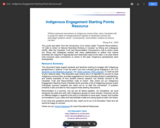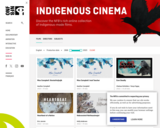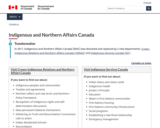
Options are provided for I DO, WE DO and YOU DO for this very well-planned Grade 7/8 project.
- Subject:
- English Language Arts
- Indigenous Perspectives
- Social Studies
- Treaty Education
- Material Type:
- Activity/Lab
- Unit of Study
- Date Added:
- 11/21/2019

Options are provided for I DO, WE DO and YOU DO for this very well-planned Grade 7/8 project.

Aboriginal children under age 14 make up 7% of all children in Canada and the Aboriginal population is the fastest growing demographic in this country. Eighty percent of Aboriginal children attend off-reserve provincial schools. In terms of school success, there are significant gaps in learning outcomes and graduation rates between Aboriginal and non-Aboriginal students.
This site provides many links to articles and resources that discuss this issue and provide examples of how different provinces are striving to close that gap and improve the educational opportunities to help Aboriginal students meets academic success.

Eleven of the ninety-four Calls to Action of the Truth and Reconciliation Commission of Canada (TRC) final report are specific to education. Call to Action 63, “Building student capacity for intercultural understanding, empathy, and mutual respect,” challenges Canadian education systems to focus on students’ understanding of Indigenous human rights and social justice initiatives. Non-Indigenous students are now beginning to learn about the truth of residential schools, treaties and other long-standing issues facing Indigenous communities such as lack of clean drinking water, housing and food shortages. Truth and reconciliation is a spiritual and emotional journey required of all students and educators – from the head to the heart – that will unfold differently for everyone.

Have you ever wondered what it would be like to live in an igloo?It would be pretty cold compared to the houses we live in now. Could you imagine living with over forty other people in one big house? Living with that many people would be like sharing a house with your whole class and all the teachers in your school!
The environment that we live in affects everything that we do. Canada is a country with a lot of different environments. There are parts of Canada where the temperature is freezing and all you can see is snow for most of the year. There are places where it rains a lot of the time and places where it is very dry. There are places that have mountains and some that are flat. There are rivers, lakes and oceans. Canada has a very diverse landscape.
In the past, First Nations were the only people living in Canada.They are the First Nations because they were the first occupants of North America. In Canada, each First Nation had to adapt to their environment in different ways. The houses they built, the food they ate, and the activities they did were all greatly affected by the environment they lived in.
Here you can look at three different aboriginal cultures from three different parts of Canada: the Huron, the Haida, and the Inuit. You can compare them to see how different their ways of life were because of where they lived.
Teaching resources available.

In this video from 2008, Nokomis Josephine Mandamin vividly recounts her walk around the Great Lakes. Along with her contagious passion and leadership, it is evident that Nokomis was also a gifted storyteller and a natural educator—leading relentlessly by example and with heart. Nokomis used every fibre of her being to advocate for not only her own Peoples, but for all life on Earth. Her love and spirit of life will flow through coming generations, rippling into relationships of reciprocity all across Turtle Island. We wish her spirit a peaceful journey home.
Carrying Her Message
• See how Nokomis supported and inspired one Thunder Bay teacher and his classroom of junior water walkers (and eventually, the whole school) to infuse science and technology into their water inquiry, in partnership with the Google Earth Educator Community. Read Peter Cameron's blog post, and explore #juniorwaterwalkers' awesome Google Earth project.
• See how Nokomis inspired our past Burtynsky Award winner, Jennifer Baron, to lead a water inquiry with her students in partnership with York Region District School Board's First Nations, Métis, and Inuit Curriculum Leads, Towana Brooks and Hayley Williamson. More than 200 students led a water walk around Lake Simcoe.
• Primitive Entertainment has made WATERLIFE, a documentary about water that features a small part of Nokomis's story, narrated by Gord Downie, free online for an extended period of time.

The Children’s Health and Well-being Measure (ACHWM) is a tool that gives Indigenous communities and organizations an overview of the health and well-being of children and youth in their communities.
The measure offers insight into children's Spiritual, Emotional, Physical, and Mental wellness.
The survey is completed on a tablet that engages children and acts as a catalyst for honest conversation. The results are shared with each child or youth in a visual form on the Balance Chart.

This site includes the following: (plus other information pertaining to Aboriginal Education in Manitoba and Canada)
It's Our Time: First Nations Education Tool Kit Teacher's Guide (National and Manitoba)
Creating Racism-Free Schools through Critical/Courageous Conversations on Race
Critical/Courageous Conversations on Race: What your child is learning at school and how you can help

This document helps support students and teachers wishing to engage with Indigenous perspectives in science. It also covers why it is important to connect to local Indigenous communities, provides suggestions on how to develop student understanding, and shares examples of how student science research can directly connect to the
Canadian Truth and Reconciliation Calls to Action.
Also check out the Indigenous Engagement Starting Points Checklist which provides a list of Indigenous groups and/or individuals you/your students can reach out to, to start this connection. A question checklist is also provided to help support those starting discussions.

In honour of Truth and Reconciliation Week, the Canadian Olympic School Program is proud to feature the stories of two distinct Indigenous Team Canada athletes, Jesse Cockney and Jillian Weir. Through their personal growth and achievements, they have brought Indigenous voices to the forefront.
Students will explore the themes of gratitude and inclusion, making links between their world, curriculum and stories.
Athlete Stories are available in two different reading levels, Kindergarten – Grade 3 and Grade 4- 6. Each story is accompanied by discussion questions and learning activities that teachers can easily integrate into their curriculum.

Indigenous people from every region of Canada served in the armed forces during the Second World War, fighting in every major battle and campaign of the conflict. To serve their country, Indigenous people had to overcome unique cultural challenges. Their courage, sacrifices, and accomplishments are a continuing source of pride to their families, communities, and all Canadians.
This site outlines the many outstanding accomplishments of Indigenous people in WWII.

This site offers a wide range of FNMI resources for grades K-12.

Indigenous people have long passed on knowledge from generation to generation through oral traditions, including storytelling. Storytelling teaches history, values, beliefs and ways of life.
Enjoy this series of oral stories told by Elder Hazel, where you'll hear all kinds of fascinating stories.

The University of Saskatchewan Indigenous Studies research portal.

This is an Indigenous Studies Portal Research Tool with links for the following areas:
economic development
indigenous knowledge
spirituality
arts and literature
research methods
science
governance
health
education
culture and society
law
history
miscellaneous

Welcome to the Teacher’s Guide for Indigenous War Heroes, developed by the Wasauksing War Hero and Native Veteran’s Educational Awareness and Commemoration Project. The guide and associated website use the story of Francis Pegahmagabow as a launching point to provide educators and students with a framework and resources for understanding the military contributions of First World War Indigenous soldiers, as well as the cultural and political landscapes in which they lived.
The lesson plans explore the connections Francis Pegahmagabow’s life story has with many Indigenous veterans, thus helping illustrate the larger picture of Canada’s historical relationship with local Indigenous peoples. However, it is important to note there are always a diversity of stories and experiences in any complex situation. Not all Indigenous veterans’ experiences will be the same, and all unique stories are valuable contributions to our overall understanding of history.

Indigenous and Northern Affairs Canada (INAC) continues to renew the nation-to-nation, Inuit-Crown, government-to-government relationship between Canada and First Nations, Inuit and Métis; modernize Government of Canada structures to enable Indigenous peoples to build capacity and support their vision of self-determination; and lead the Government of Canada's work in the North.

This YouTube channel offers many videos with Indigenous content.
Please subscribe for more INAC videos: http://goo.gl/esyayp
Get more INAC: http://www.aadnc-aandc.gc.ca/

From St. John's Newfoundland, to Haida Gwaii, British Columbia and Cape Dorset, Nunavut, Aboriginal and northern people and communities across Canada have success stories to share.
Through this website you can learn about community-driven efforts to improve the lives of Aboriginal and non-Aboriginal individuals, families and communities.

Discover the NFB’s rich online collection of Indigenous-made films.

Throughout Canada's history, Indigenous peoples have helped shape this land into the country we know today. Before Canada became a country, Britain's military alliances with First Nations were a key part of the defensive network of British North America.
During the War of 1812, First Nations warriors and Métis fighters played important roles in the defence of these British territories against invading American forces. Thousands of First Nations warriors and Métis fighters fought beside British troops and Canadian settler militias during the war.
These Indigenous allies were often accompanied by officials from the Indian Department who spoke Indigenous languages and who could help First Nations war chiefs and British military commanders speak to each other.
First Nations and Métis communities sided with the British during the war because they shared a common goal: to resist American expansion. More than 10,000 First Nations warriors from the great lakes region and the St. Lawrence Valley participated in nearly every major battle.
For British military leaders such as Major-General Sir Isaac Brock, commander of Britain's forces, First Nations warriors strengthened local garrisons and were seen as exceptional fighters.
In Canada, the war was fought on three main fronts: in the western great lakes region, the Niagara region and the St. Lawrence region. In each region First Nations warriors helped repel the invading American forces.
First Nations warriors from the Ojibwa and Dakota fought at the Battle of Michilimackinac. The Ojibwa, Odawa, Pottawatomi and Shawnee fought at the capture of Detroit. Six Nations warriors fought during the battles of Queenston Heights and Beaver Dams. The Algonquin, Mohawk, Huron and Abenaki fought at the Battle of Châteauguay.
According to several British commanders, these important battles were won in large part because of the participation of their Indigenous allies.